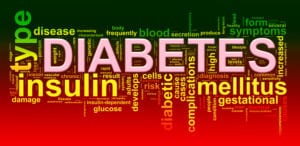Written by Halima Phelps, DC, ND. Residents from the Mediterranean area of Catalonia had elevated blood levels of iron, (serum ferritin [SF]) that were associated with an increased risk of developing type 2 diabetes.
 Oftentimes diabetes mellitus (DM) is defined by etiologies of heredity, poor weight control, and inadequate diet and lifestyle choices. The condition is a major health problem globally, and has been increasing annually. Less known, perhaps, is the potential to acquire DM due to an underlying issue of iron overload. Iron overload can be caused by a variety of conditions: including genetic disorders such as hereditary hemochromatosis and thalassemia major 1. The presence of these conditions has historically predisposed affected individuals to acquiring DM, which genders the question of whether a non-specific case of overload of iron is also responsible for the disease. One Norfolk study found a positive correlation between elevated SF alone and the potential of acquiring DM 2.
Oftentimes diabetes mellitus (DM) is defined by etiologies of heredity, poor weight control, and inadequate diet and lifestyle choices. The condition is a major health problem globally, and has been increasing annually. Less known, perhaps, is the potential to acquire DM due to an underlying issue of iron overload. Iron overload can be caused by a variety of conditions: including genetic disorders such as hereditary hemochromatosis and thalassemia major 1. The presence of these conditions has historically predisposed affected individuals to acquiring DM, which genders the question of whether a non-specific case of overload of iron is also responsible for the disease. One Norfolk study found a positive correlation between elevated SF alone and the potential of acquiring DM 2.
The aim of this longitudinal cohort study is to further examine whether SF has a direct association with the development of DM, adding further clarity to the conflicting results found in previous studies of iron levels being an independent variable– as well as if there is a gender predilection toward the development of the disease, using a large patient base. If there is a determination of SF being an independent factor in the development of the disease, this could potentially provide a therapeutic method toward the mitigation and prevention of DM.
In this study, sociodemographic and other medical information between the years of 2006-2016 from 206,115 men and women was extracted from a medical database called the Information System for Research in Primary Care (SIDIAP). Participants who were ages 35-75 years old from Catalonia in the Mediterranean and had an initial recording of SF levels with no medical history of DM Type II were examined under this study. They were unable to participate in the study if they were on iron supplementation or medication for the treatment of DM, or if they had a history of hemochromatosis, or other interfering conditions such as chronic illness.
After 8.4years a follow-up was performed among participants. Results of this study revealed that a higher SF amount was present in the participants that presented with the development of Type 2 DM. This was true for both the male and female categories. Women with elevated SF levels had a 1.49 relative risk (RR) of developing DM over the length of the study, and men were at a RR of 1.74 (SF≥82.8 for women and SF ≥258.1 µg/L for men). There was an average of 7.5 DM cases per 1000 participants each year. The development of DM cases was consistent with the participants who had higher SF levels to begin with (107.0 µg/L compared to 60.3 µg/L, where p<0.001). The incidence rate of DM rose concurrently with the increase in SF levels as evidenced in four quartiles from low to high. Unadjusted baseline SF was 9.9% for the highest quartile (Q) Q4, down to 3.8% for the lowest Q1, (quartiles were from 1 being the lowest to 4 being highest). The hazard ratio (HR) for Q4 compared to Q1, unadjusted via Cox regression, was 2.68 (95% confidence interval (CI) =2.54-2.82 where p<0.001); for Q3 compared to Q1 the HR=1.57 (95% CI=1.49-1.66 where p<0.001), and Q2 compared to Q1 the HR=1.15 (95%CI=1.08-1.22 where p<0.001; with all p-trend values significant at p<0.001). This supports the hypothesis of SF, without Cox regression model adjustments, as a positive measurement for predicting potential future development of DM.
Following adjustments for HR, using Cox proportional-hazards regression models: (Model 1 being an adjustment for age and gender, Model 2 for smoking, alcoholism, dyslipidemia and hypertension status, Model 3 for body mass index, and Model 4 for C-reactive protein [an inflammation marker]), there was still a consistent finding of a significantly increased prevalence of DM. HR for Model 4, by comparing each quartile to the lowest value (with 1.00 being the reference value following adjustments), were Q2 compared to Q1: HR= 0.95 (95% CI=0.85-1.06 where p=0.370), Q3 compared to Q1: HR=1.18 (95% CI=1.65-1.31 where p=0.001), and Q4 compared to Q1: HR= 1.51(95% CI=1.36-1.65, where p<0.001). These results still primarily suggest a significantly higher prevalence of diabetes following the Cox regression model adjustments for factors such as inflammatory status, as specifically seen here.
Results of this study were consistent with findings of previous studies suggesting a correlation of ferritin being a predictive biomarker for the development of DM 1,2. As a value that can simply be obtained via laboratory evaluation, it should be medically considered as a measurement to be monitored to aid in the prevention of such a biologically and economically stressful disease globally experienced. Future studies should include a more culturally diverse group to determine consistency of results.
Source: Díaz-López, A.; Iglesias-Vázquez, L.; Pallejà-Millán, M.; Rey Reñones, C.; Flores Mateo, G.; Arija, V. Association between Iron Status and Incident Type 2 Diabetes: A Population-Based Cohort Study. Nutrients 2020, 12, 3249.
© 2020 by the authors. Licensee MDPI, Basel, Switzerland. This article is an open accessarticle distributed under the terms and conditions of the Creative Commons Attribution(CC BY) license (http://creativecommons.org/licenses/by/4.0/)
Posted January 4, 2021
References:
- Podmore C, Meidtner K, Schulze MB, et al. Association of Multiple Biomarkers of Iron Metabolism and Type 2 Diabetes: The EPIC-InterAct Study. Diabetes Care. 2016;39(4):572-581.
- Forouhi NG, Harding AH, Allison M, et al. Elevated serum ferritin levels predict new-onset type 2 diabetes: results from the EPIC-Norfolk prospective study. Diabetologia. 2007;50(5):949-956.

